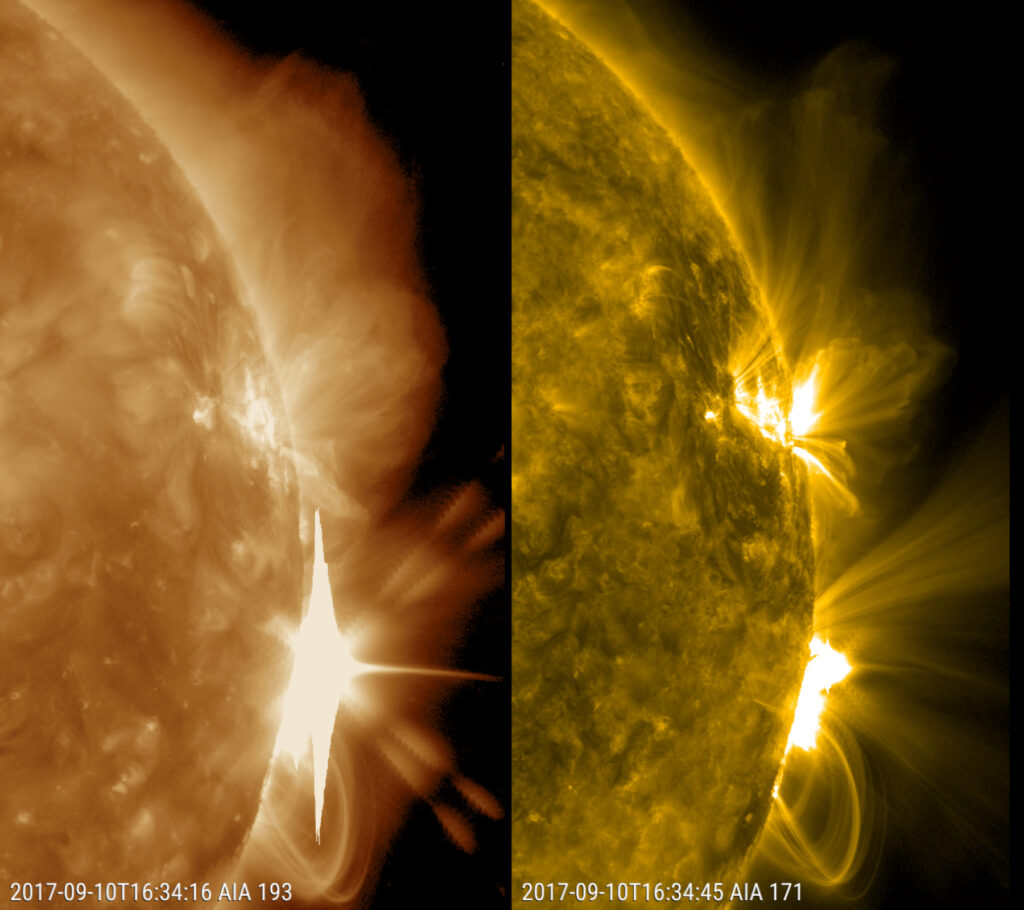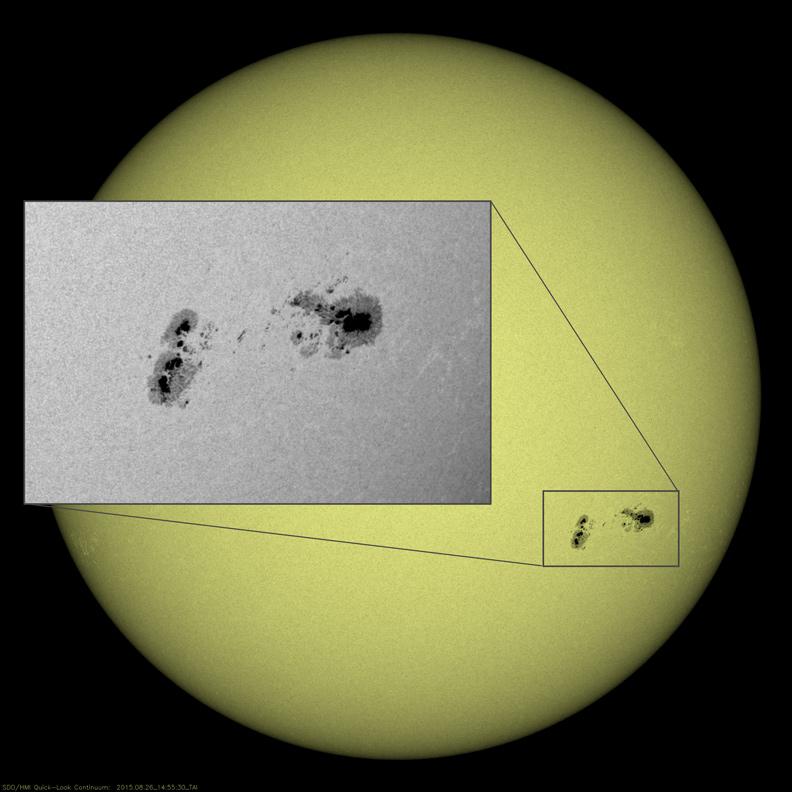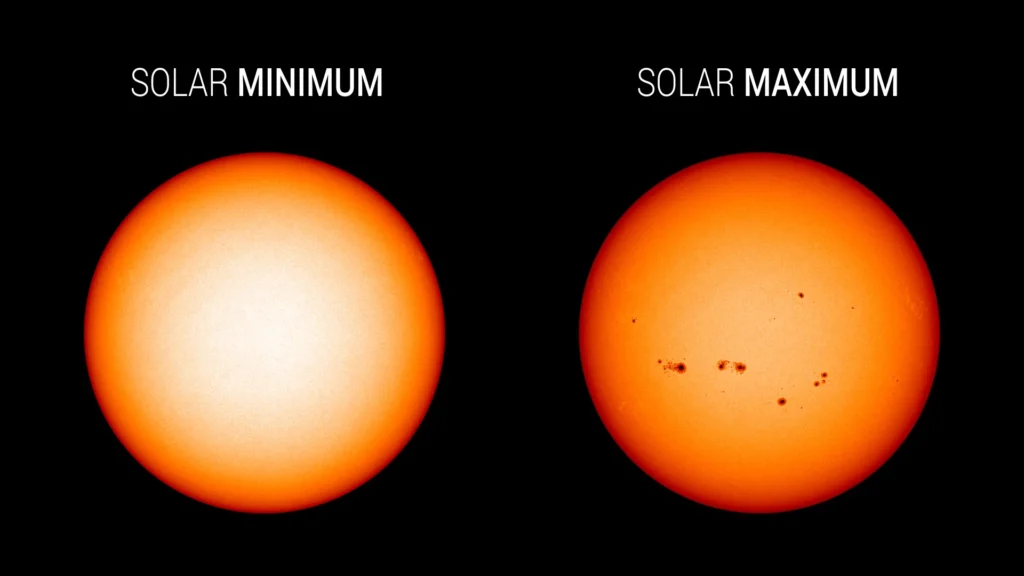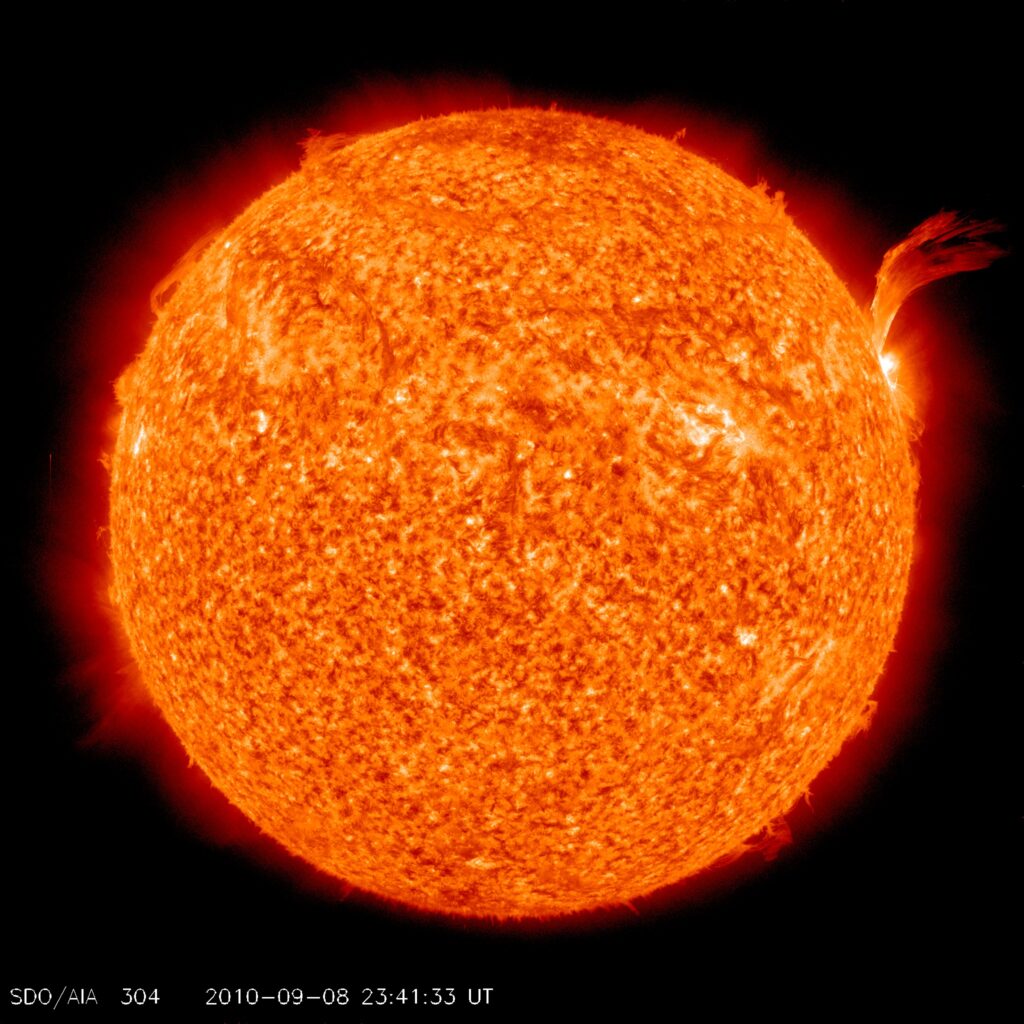Imagine gazing at the Sun (safely, of course) and witnessing dark spots moving across its fiery surface. These are sunspots, and they’re central to understanding our star’s behavior and its far-reaching impact on our planet and beyond. From influencing Earth’s climate to affecting our modern technology, sunspots play a crucial role in the intricate relationship between the Sun and Earth.
In this article, we’ll delve deep into the world of sunspots, exploring their nature, formation, and effects. By the end, you’ll have a comprehensive understanding of these solar phenomena and their importance in the grand cosmic dance that influences our daily lives.
What Are Sunspots, and Why Do They Occur?

Defining Sunspots
Sunspots are temporary dark areas on the Sun’s photosphere, the visible surface of our star. These regions appear darker because they are cooler than their surroundings—but don’t be fooled, they are still incredibly hot at about 4,000-4,500 Kelvin (compared to the surrounding 5,800 Kelvin surface).
Key characteristics of sunspots include:
- Darker Appearance: Sunspots appear dark against the bright solar surface due to temperature contrast.
- Cooler Temperatures: Despite being cooler than their surroundings, sunspots are still incredibly hot – hotter than the core of Earth!
- Strong Magnetic Fields: Sunspots are areas of intense magnetic activity, with field strengths thousands of times stronger than Earth’s magnetic field.
- Varying Sizes: Sunspots can range from tiny pores barely visible with powerful telescopes to massive spots visible from Earth with proper eye protection.
- Complex Structure: Larger sunspots often have two distinct parts – a dark central region called the umbra, surrounded by a lighter region known as the penumbra.
The Formation of Sunspots
Sunspots are a complex process that starts deep within the Sun itself, in the convection zone where plasma movements create strong magnetic fields. It happens in several stages. First, the internal dynamo creates magnetic fields that rise through the convection zone and get twisted and knotted as they go. These twisted magnetic field lines eventually break through the surface of the Sun and create areas of high magnetic activity called sunspots.
Once these magnetic fields get through the surface of the Sun they suppress the normal convective flow of hot plasma from the inside of the Sun. This suppression causes a cooling effect in the sunspot regions compared to their surroundings and they appear darker against the brighter surface of the Sun. As sunspots develop they can grow, shrink, or even merge with neighboring spots as the magnetic forces continue to shape their evolution.
It’s all cyclical and ongoing, driven by the Sun’s magnetic dynamo, and results in sunspot number fluctuations we call the solar cycle. These cycles are about 11 years from one maximum to the next, maximum and minimum sunspot activity has big implications for solar and space weather.
The Dark Nature of Sunspots
Sunspots are dark against the Sun’s surface because of a 1,500 Kelvin temperature difference from their surroundings. The temperature difference plus the lack of convection due to strong magnetic fields means less radiation is emitted from sunspots making them even darker. The contrast with the bright surface and the complexity of bigger sunspots with dark umbra and lighter penumbra regions makes them look so striking.
Interestingly, while sunspots look dark against the Sun, they would be super bright if isolated against a dark background, so their darkness is relative and not because they are intrinsically dim or cold.
Historical Discovery of Sunspots

Humans have been observing sunspots for over 2,000 years, and we’ve been fascinated with the universe for that long. Ancient Chinese, Greek and Roman scholars recorded sunspots as far back as 364 BCE. The medieval period saw continued observations, the first known sunspot drawing was by John of Worcester in 1128.
The invention of the telescope in the 17th century changed everything, Galileo Galilei’s systematic observations in 1610 challenged the idea that the Sun was perfect. His work and that of contemporaries like Thomas Harriot and Christoph Scheiner laid the foundation for modern solar physics. T
The field really took off in the 19th and early 20th centuries, Samuel Heinrich Schwabe discovered the sunspot cycle in 1843 and George Ellery Hale proved in 1908 that sunspots were areas of intense magnetic activity. From naked eye observations to modern science, we’ve come a long way in understanding the Sun and how dynamic it is.
Lifespan of Sunspots
Sunspots come in all shapes, sizes, and lifetimes. Small ones can last only a few hours or days and larger ones weeks or even months. On average they last about 2 weeks. Factors that influence their lifetime are the size of the sunspot, the strength of the magnetic field, and the complexity of the sunspot group. Larger sunspots with stronger magnetic fields and more complexity last longer especially during high solar activity. The lifecycle of a sunspot is formation, maturation, decay, and disappearance as the magnetic field weakens and normal convection resumes.
The Solar Cycle and Sunspot Activity
Understanding the Solar Cycle
The solar cycle is cool. It’s what governs the Sun’s magnetic activity and has big effects on our solar system. This 11-year solar activity cycle is key to understanding the Sun and how it affects Earth. On average it’s 11 years but can be 9 to 14. At the start of each cycle, the Sun’s magnetic field is in one direction. Over the cycle, the field weakens, reverses, and strengthens in opposite directions. This full reversal and back to the original state is one full solar cycle.
Sunspot numbers go up and down with the solar cycle and are a measure of the cycle. At solar minimum few sunspots are visible but as the cycle progresses sunspot numbers increase and peak at solar maximum. The solar cycle affects many solar phenomena including more frequent and intense solar flares, coronal mass ejections (CMEs), variations in solar wind strength and composition, and slightly higher solar irradiance at solar maximum. Scientists use sunspot numbers, solar flux measurements, and geomagnetic indices to track the solar cycle.
We’ve been systematically observing the solar cycle since the mid-18th century and we are currently in Solar Cycle 25 which started in December 2019. Understanding the solar cycle is key to predicting space weather which can affect satellite operations, power grids, and communication systems on Earth and gives us insight into the Sun’s internal dynamics and the solar dynamo that generates its magnetic field.
Sunspot Minimums and Maximums

The solar cycle has periods of high and low sunspot activity, solar maximum and solar minimum. These phases are important for solar dynamics and affect Earth and our technology. During the solar minimum there are few sunspots on the surface of the Sun and overall solar activity is reduced, space weather is calm. This phase lasts 1-3 years and can result in more cosmic rays hitting Earth, a cooling of the upper atmosphere and reduced aurora.
On the other hand the solar maximum is marked by many sunspots on the surface of the Sun, increased solar activity and more frequent solar flares and coronal mass ejections. This phase lasts 2-4 years and brings increased risk of geomagnetic storms on Earth, more frequent and vivid auroras and disruptions to satellite operations and communications. The transition from minimum to maximum takes about 4 years and from maximum to minimum about 7 years.
Not all solar cycles are equal. Some have higher peaks with more sunspots at maximum than others, and the duration of minimums and maximums can vary between cycles. These variations are caused by changes in the Sun’s magnetic field, variations in solar plasma flows and complex interactions inside the Sun. The solar dynamo which generates the Sun’s magnetic field goes through cycles and affects the emergence of magnetic flux at the surface which results in sunspot formation. Some theories suggest that planetary alignments or other external factors might modulate the solar cycle but that’s still a topic of debate.
Current Sunspot Activity
As of 2024, Solar Cycle 25, which began in December 2019, is in its early stages and showing increased activity. The sun is getting more active and early signs are that Cycle 25 may be stronger than Cycle 24 but still a moderate cycle. We’re seeing several big sunspot groups and they’re producing some big solar flares and coronal mass ejections. Peak activity or solar maximum is expected around 2025 with a sunspot number peak of 95-130, higher than Cycle 24 but lower than historical averages.
Sunspots, Solar Flares, and Their Effects on Earth

Sunspots and solar flares are connected and if you want to understand solar activity and space weather you need to understand sunspots. They are areas of intense magnetic activity and often the birthplace of solar flares. As sunspots evolve their magnetic fields get more and more twisted and stressed until they snap and release huge amounts of energy as solar flares. Larger more complex sunspot groups produce more powerful flares which are classified from A-class (weakest) to X-class (strongest). Monitoring the size, complexity and magnetic strength of sunspot groups is key to predicting solar flares and understanding the Sun.
Solar flares have big effects. Electromagnetic radiation from flares can knock out radio communications and GPS on Earth, solar energetic particles can damage satellites and astronauts. Coronal mass ejections (CMEs) often accompany big flares and if directed at Earth can cause geomagnetic storms. Historical events like the Carrington Event of 1859 and the Halloween Storms of 2003 show the impact of these solar events. Research is ongoing to better understand the connection between sunspots and solar flares so we can improve space weather forecasting and mitigation to protect our technology and infrastructure.
Conclusion
Sunspots, these dark and weird things on our Sun, are key to understanding solar activity and its effects on Earth and beyond. From our climate and technology to space weather forecasting sunspots are still a hot area of research for astronomers and space scientists.
As we go deeper into the Sun and its behaviour sunspot research will no doubt reveal more about our star and its impact on our solar system. By understanding sunspots we get to see the intricate and beautiful dance of celestial forces that shape our cosmic backyard.
Frequently Asked Questions About Sunspots
How do sunspots affect the Earth?
Sunspots affect Earth primarily through their association with solar flares and coronal mass ejections (CMEs). These events can cause geomagnetic storms, potentially disrupting satellite operations, radio communications, and electrical grids. They also contribute to beautiful auroras. While not directly causing day-to-day weather changes, long-term sunspot activity may have subtle influences on Earth’s climate.
Are sunspots hot or cold?
Sunspots are cooler than the surrounding solar surface, but they’re still incredibly hot. The dark center (umbra) of a sunspot is typically around 4,000-4,500 Kelvin (about 6,700-7,600°F or 3,700-4,200°C), while the surrounding solar surface is about 5,800 Kelvin (about 10,000°F or 5,500°C). Despite being “cooler,” sunspots would still be blindingly bright if viewed against a dark background.
What is the main cause of sunspots?
Sunspots are caused by intense magnetic activity on the Sun’s surface. They form when strong magnetic fields emerge from the Sun’s interior and break through the photosphere (visible surface). These magnetic fields inhibit the normal convection process that brings hot plasma to the surface, resulting in cooler, darker areas we see as sunspots.
Can you see sunspots from Earth?
Yes, some larger sunspots can be seen from Earth with proper eye protection. However, NEVER look directly at the Sun without specialized equipment, as it can cause severe eye damage. Safe methods to observe sunspots include:
- Using a telescope with a certified solar filter
- Projecting the Sun’s image onto a white surface using a pinhole camera
- Viewing through special eclipse glasses during large sunspot events
Do sunspots appear suddenly?
While sunspots can emerge relatively quickly, they don’t typically appear instantaneously. Small sunspots can form in a matter of hours, while larger, more complex sunspot groups may take several days to fully develop. Their appearance is often preceded by visible changes in the Sun’s magnetic field structure, which solar physicists can detect using specialized instruments.
How long do sunspots last?
The lifespan of sunspots varies greatly. Smaller sunspots might last only a few hours or days, while larger, more complex sunspot groups can persist for several weeks or even months. On average, a typical sunspot lasts about two weeks.
Do sunspots occur in cycles?
Yes, sunspot activity follows a roughly 11-year cycle known as the solar cycle. During solar maximum, there are many sunspots, while during solar minimum, there are few to none. This cycle is tied to the periodic reversal of the Sun’s magnetic field.
Can sunspots affect human health?
Sunspots themselves don’t directly affect human health. However, the increased solar activity associated with sunspots can lead to higher levels of solar radiation, which might pose risks to astronauts in space or passengers on high-altitude flights. On Earth’s surface, we’re generally well-protected by our planet’s atmosphere and magnetic field.
Are all sunspots the same size?
No, sunspots vary greatly in size. The smallest observable sunspots, called pores, are about 2,500 kilometers in diameter. The largest sunspots can be over 80,000 kilometers across, large enough to swallow Earth several times over. For comparison, Earth’s diameter is about 12,742 kilometers.
How are sunspots related to solar flares?
Sunspots and solar flares are closely related. Solar flares typically occur near sunspots, particularly in magnetically complex sunspot groups. The intense magnetic activity in sunspot regions can lead to sudden releases of energy in the form of solar flares when magnetic field lines reconnect.
Do other stars have sunspots?
Yes, other stars can have starspots, which are analogous to sunspots. These dark spots on other stars are caused by the same magnetic processes that create sunspots on our Sun. Observing starspots helps astronomers understand stellar magnetic activity and rotation across different types of stars.
